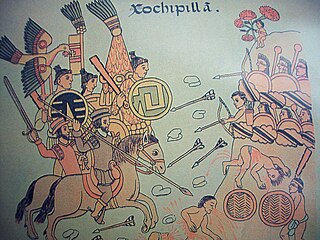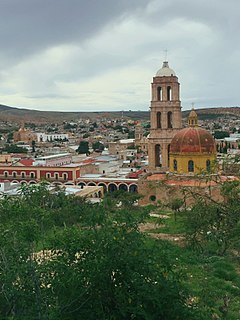
Zacatecas is the principal city within the municipality in Mexico of the same name, and the capital and the largest city of the state of Zacatecas. Located in north-central Mexico, the city had its start as a Spanish mining camp in the mid-16th century. Native Americans had already known about the area's rich deposits of silver and other minerals. Due to the wealth that the mines provided, Zacatecas quickly became one of the most important mining cities in New Spain. The area saw battles during the turbulent 19th century, but the next major event was the Battle of Zacatecas during the Mexican Revolution when Francisco Villa captured the town, an event still celebrated every anniversary. Today, the colonial part of the city is a World Heritage Site, due to the Baroque and other structures built during its mining days. Mining still remains an important industry. The name Zacatecas is derived from the Zacateco people and has its roots in Nahuatl. The name means "people of the grasslands".

Chichimeca is the name that the Nahua peoples of Mexico generically applied to nomadic and semi-nomadic peoples who were established in present-day Bajio region of Mexico. Chichimeca carried the same sense as the Roman term "barbarian" to describe Germanic tribes. The name, with its pejorative sense, was adopted by the Spanish Empire. For the Spanish, in the words of scholar Charlotte M. Gradie, "the Chichimecas were a wild, nomadic people who lived north of the Valley of Mexico. They had no fixed dwelling places, lived by hunting, wore little clothes and fiercely resisted foreign intrusion into their territory, which happened to contain silver mines the Spanish wished to exploit." In spite of not having temples or idols, they practiced animal and human sacrifice, and they were feared for their expertise and brutality in war.
The Tlaxcalans, or Tlaxcaltecs, are a Nahua people who live in the Mexican state of Tlaxcala.

The Guachichil, Cuauchichil, or Quauhchichitl, are an Indigenous people of Mexico. Pre-contact, they occupied the most extensive territory of all the indigenous Chichimeca Nations tribes in pre-Columbian Central Mexico.

The Caxcan were a partly nomadic indigenous people of Mexico. Under their leader, Tenamaztle, the Caxcan were allied with the Zacatecos against the Spaniards during the Mixtón Rebellion in 1540-42. During the rebellion, they were described as "the heart and the center of the Indian Rebellion". After the rebellion, they were a constant target of the Zacatecos and Guachichiles due to their ceasefire agreement with the Spaniards. Their principal religious and population centers were at Teul, Tlaltenango, Juchipila, and Teocaltiche.

The Mixtón War (1540-1542) was a rebellion by the Caxcan people of northwestern Mexico against the Spanish conquerors. The war was named after Mixtón, a hill in Zacatecas which served as an Indigenous stronghold.

The Chichimeca War (1550–90) was a military conflict between the Spanish Empire and the Chichimeca Confederation established in the territories today known as the Central Mexican Plateau, called by the Conquistadores La Gran Chichimeca. The epicenter of the hostilities was the region now called the Bajío. The Chichimeca War is recorded as the longest and most expensive military campaign confronting the Spanish Empire and indigenous people in Mesoamerica. The forty-year conflict was settled through several peace treaties driven by the Spaniards which led to the pacification and, ultimately, the streamlined integration of the native populations into the New Spain society.

The Guamare people were an indigenous people of Mexico, who were established mostly in Guanajuato and at the border of Jalisco. They were part of the Chichimecas, a group of a nomadic hunter-gatherer culture and called themselves Children of the Wind, living religiously from the natural land. As a tradition, they would cremate their dead and spread their ashes into the wind back to 'Mother Earth'. The Guamare people were politically united with the Chichimeca Confederation, but like other Chichimeca nations were independent. The Chichimeca were established in the present-day Bajio region of Mexico.

The Tecuexe were an indigenous peoples of Mexico, who lived in the eastern part of present-day Guadalajara.

Sombrerete is a town and municipality located in the northwest of the Mexican state of Zacatecas, bordering the state of Durango.

The Bolsón de Mapimí is an endorheic, or internal drainage, basin in which no rivers or streams drain to the sea, but rather toward the center of the basin, often terminating in swamps and ephemeral lakes. It is located in the center-north of the Mexican Plateau. The basin is shared by the states of Durango, Coahuila, Chihuahua, and Zacatecas. It takes its name from Mapimí, a town in Durango.

The Tepehuán Revolt broke out in Mexico in 1616 when the Tepehuán Indians attempted to break free from Spanish rule. The revolt was crushed by 1620 after a large loss of life on both sides.

Peralta is a prehispanic mesoamerican archaeological site located in Abasolo Municipality, Guanajuato, just outside the village of San Jose de Peralta in the Mexican state of Guanajuato. The site is reached via Fed 90 from Irapuato. Approximately 15.5 km south of the intersection with Fed 45, take the Irapuato-Huanimaro route southeast (left). Follow the route for about 12.5 km, then turnoff southwest (right) to San Jose de Peralta. Cross the bridge and turn right, and then follow the road out of the village northwest about 1 km. The site is on the left.

Plazuelas is a prehispanic archaeological site located just north of San Juan el Alto, some 2.7 kilometers (1.57 mi.) north of federal highway 90 (Pénjamo-Guadalajara), and about 11 kilometers (6.8 mi.) west of the city of Pénjamo in the state of Guanajuato, Mexico. The site is open to the public; it is dominated by a large, rectangular plaza with several pyramidal structures and platforms, along with a massive ball court. To the north of the structures is a field of boulders with thousands of glyphs carved into them.

Francisco Tenamaztle, also Tenamaxtlan, Tenamaxtli or Tenamaxtle, was a leader of the Caxcan indigenous peoples in Mexico during the Mixtón War of 1540–1542. He was later put on trial in Spain. With the support of Bartolomé de las Casas he defended the justice of his cause by appealing to King Carlos I.
El Cóporo is a prehispanic archaeological site at the northern frontiers of the Mesoamerican cultural area, located at an elevation of 150 meters on the western slopes of the Santa Bárbara range, near the San José del Torreón community, and lies some 15 kilometres (9 mi) due south of its municipal seat and largest township, on the northwestern corner of Guanajuato state, Mexico.
El Opeño is a Mesoamerican archaeological site located in the municipality of Jacona in the state of Michoacán, Mexico. It is home to a prehispanic site, mainly known from the ceramic material found in the funerary complexes of the site, which have been dated to the Late Preclassic period. The importance of this site in mesoamerican archaeology is due to its antiquity and the ample diffusion of its style, contemporary to other native culture developments such as the Capacha culture and earlier than the Chupicuaro. El Opeño tombs, the oldest in Mesoamerica, have been dated to around 1600 BCE - a similar period as Olmec culture development.
El Teúl is an important archaeological Mesoamerican site located on a hill with the same name in the Teúl Municipality in the south of the Zacatecas State, Mexico, near the Jalisco State.

La Ferrería is an archaeological site located 7 kilometers south of the City of Durango, in the state of Durango, México, at the “Cerro de La Ferrería”, on the side of the Tunal River.

Huandacareo is an archaeological zone located about 60 kilometers north of the city of Morelia, in the state of Michoacán.














